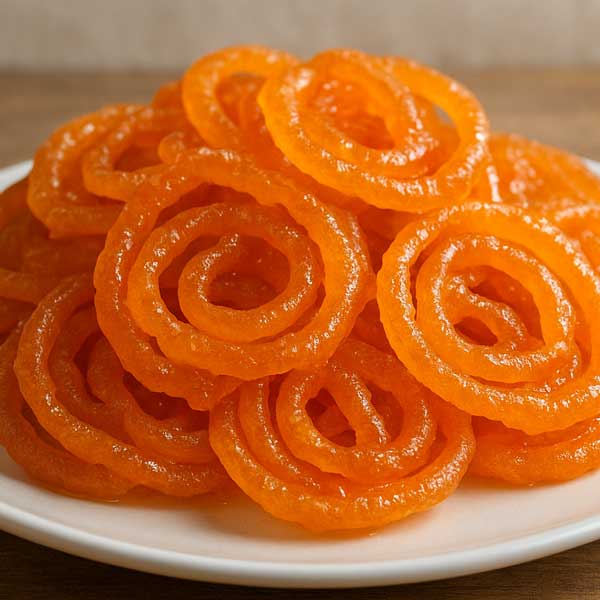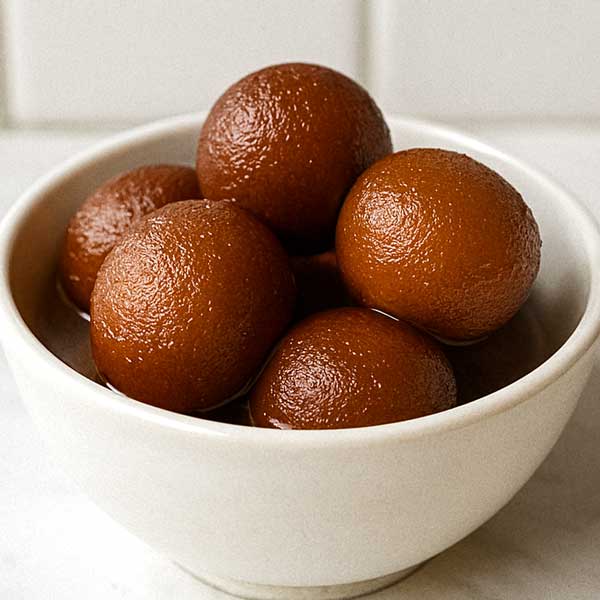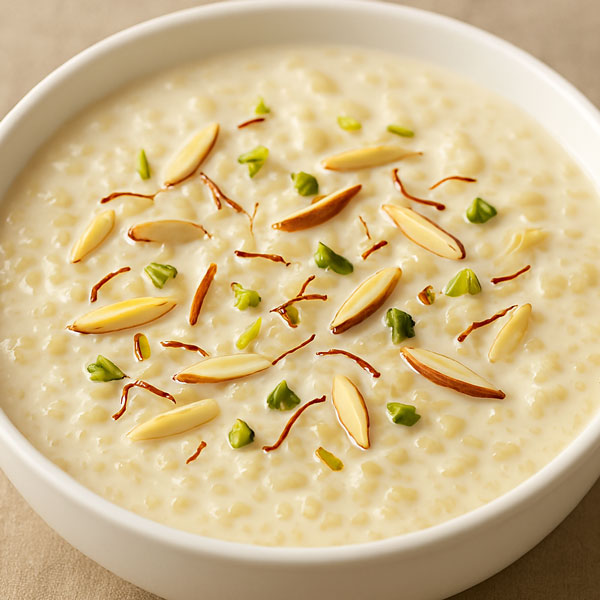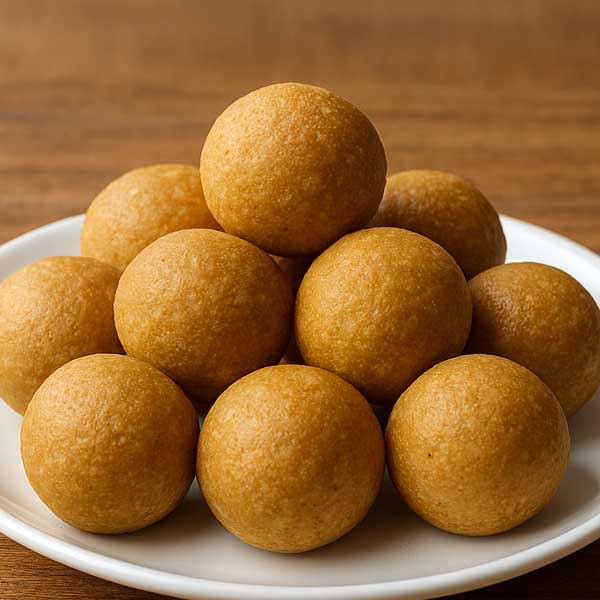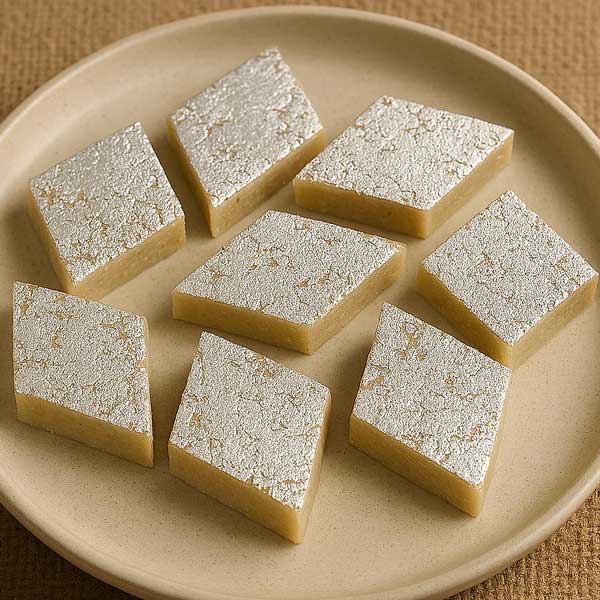Suji Halwa Recipe (Sooji Halwa)
If you’re craving a quick and traditional Indian dessert that’s easy to make with simple pantry ingredients, Suji Halwa is a perfect choice. This classic semolina pudding is loved for its rich aroma of clarified butter, soft texture, and comforting sweetness.
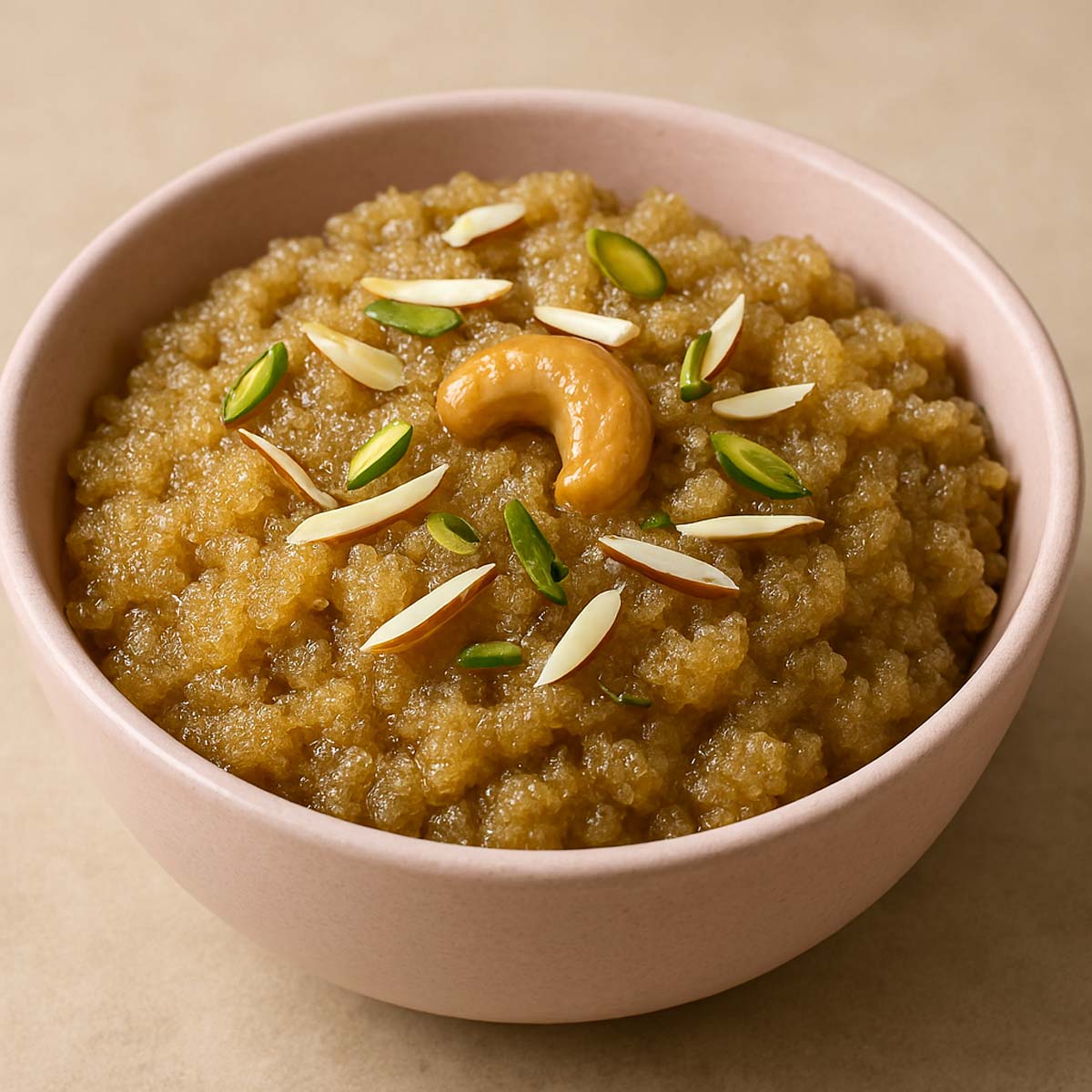
Suji Halwa, also known as Sooji Halwa, Semolina Halwa or Rava Sheera, or Indian semolina pudding, is a traditional Indian dessert made with suji (rava/semolina), ghee (clarified butter) and sugar. Halwa is known for its rich flavor, soft texture, and quick preparation. It is often served during religious festivals, pujas (rituals), or as a simple sweet dish for breakfast or dessert. This easy and quick Indian halwa recipe uses basic ingredients and is typically flavored with cardamom powder and garnished with dry fruits like cashews, almonds, and pistachios. Sooji Halwa is not only delicious but also comforting and versatile. Whether you’re looking for a festival dessert, a kids’ favorite sweet, or a 5-ingredient Indian dessert, Suji Halwa offers the same comforting sweetness found in classic Indian desserts like kheer and ladoo.
Ingredients and Substitutes
- Suji (semolina): Fine suji is the base of this traditional Indian semolina dessert. It toasts beautifully and gives halwa its soft, grainy texture. If you only have coarse suji, you can still use it just roast it a bit longer for an even golden color. As an alternative, you can also use roasted wheat rava or cream of wheat (farina), though the texture and flavor of halwa will vary slightly.
- Besan (gram flour): Just a spoonful of besan brings in a slightly earthy flavor and enhances the golden color of halwa. If you’re avoiding it, you can skip besan entirely the halwa will still turn out delicious but adding it gives a deeper aroma and makes the flavor even better, especially for festive occasions.
- Sugar: One cup of sugar brings the perfect sweetness to the halwa. You can reduce the quantity slightly if you like it less sweet, or swap with jaggery or coconut sugar for a more rustic halwa recipe. For a healthier version, jaggery or coconut sugar can be used instead to create a rustic halwa recipe.
- Water: Water is used to prepare the sugar syrup that fluffs up the semolina. I use plain water to cook the sugar syrup for suji halwa. For extra aroma, saffron strands or a dash of rosewater can be added. You can also substitute water with milk if you prefer a creamier and richer halwa.
- Ghee: It is an essential ingredient for making halwa. Ghee is what gives this ghee-based Indian dessert its rich aroma. Suji should always be roasted in ghee. Before adding the syrup, I always roast the suji in ghee till it turns light golden and smells toasty. This step prevents stickiness and adds depth of flavor. Sometimes, nuts are roasted in the same ghee to build extra richness.
- Nuts and Dry Fruits: Cashews, almonds, and pistachios together enhance the flavor, texture, and look of Suji Halwa. Cashews add a soft crunch and buttery richness, especially when lightly roasted in ghee. Almonds bring a subtle bite and a festive touch—sliced for garnish or whole for extra crunch. If you don’t have almonds, you can use sunflower seeds, walnuts, melon seeds, or skip them altogether depending on dietary needs or preferences. Pistachios, though optional, add a royal green accent, making the halwa look elegant and perfect when serving guests or preparing halwa for special occasions.
- Cardamom powder: A finishing touch of cardamom powder brings a sweet-spicy aroma typical of Indian traditional sweets. Even a small amount transforms the flavor, but if you don’t have it, the halwa still tastes great, but cardamom definitely takes it up a notch.
How to Make Suji Halwa (Step-by-Step Recipe)
- Roast the Semolina. To make sooji halwa, heat ghee in a pan and roast sooji with a little gram flour until golden and fragrant.
- Making the Sugar Syrup for Halwa. Boil water, add sugar, and stir until it dissolves into a light syrup for halwa.
- Combine Semolina and Syrup for Smooth Texture. Gradually mix the syrup into the roasted semolina, stirring to avoid lumps, and cook until thick and glossy.
- Fry the Nuts for Rich Flavor. Lightly fry cashews and almonds in a pan in ghee until golden and crisp.
- Garnish and Serve. Add fried nuts and cardamom powder, cook until the ghee separates, and serve it warm and fresh, right after cooking.
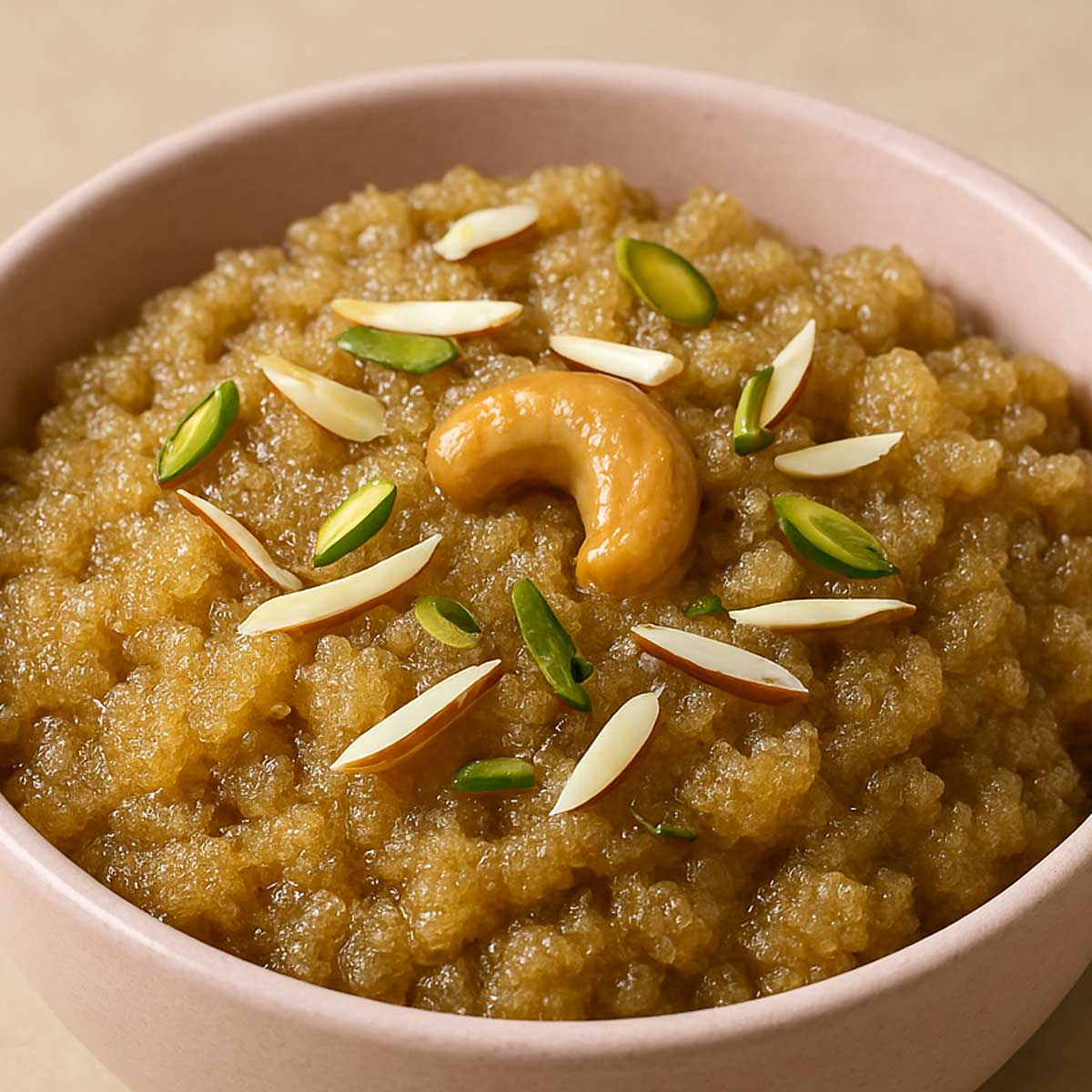
Tips for Making Suji Halwa Perfect Every Time
Use a heavy-bottomed non-stick pan or kadhai to prevent the semolina from burning and ensure even roasting. Roast the semolina slowly on low flame, not on a high heat until it reaches a rich golden color. Keep a whisk or sturdy spatula handy for continuous stirring, as halwa can stick easily.
Allow the roasted semolina to cool slightly before adding the syrup if it’s too hot, as direct pouring can cause splattering. You’ll also need a separate saucepan for boiling the sugar syrup and a small frying pan for roasting the nuts in ghee.
It’s essential for the right texture, shine, and authentic flavor of Indian Suji Halwa. I recommend you to keep a wooden spatula or silicone spoon for stirring, as halwa requires constant motion to avoid lumps.
Use warm water or milk instead of cold liquid for a creamier, lump-free consistency. Add a few strands of saffron or a touch of milk for richness. If you prefer a lighter version, replace part of the ghee with a teaspoon of neutral oil.
Serving Suggestions
Serve Suji Halwa as a comforting Indian breakfast with poori for the traditional North Indian combo, “Sooji Halwa Poori.” The ghee adds richness, while the texture remains perfectly soft and aromatic. You can reduce the sugar slightly and add raisins or grated coconut for variety.
Add saffron milk, grated coconut, or a few drops of rose water for a variation in flavor. You can also mix halwa with a scoop of vanilla ice cream for a fusion dessert. Serve a small portion of halwa in small cups or dessert glasses, garnished with a drizzle of ghee and a sprinkle of chopped pistachios, cashews or saffron strands after lunch or dinner as a quick and satisfying Indian dessert. Suji halwa is soft, mildly sweet, and perfect for children.
Frequently asked questions
Lumps in semolina halwa form when the sugar syrup is added too quickly to the roasted semolina. Always pour the syrup gradually while stirring continuously to ensure a smooth, lump-free halwa.
Roast the suji (semolina) on low flame for 6–8 minutes until it turns light golden brown. Undercooked suji results in a raw taste and overcooking may burn it.
Yes, you can substitute water with milk for a creamier, richer halwa known as milk suji halwa. Use full-fat milk for best results.
Yes, you can store it in an airtight container in the refrigerator for up to 2–3 days. Reheat halwa with a little ghee or water on low flame or microwave before serving.
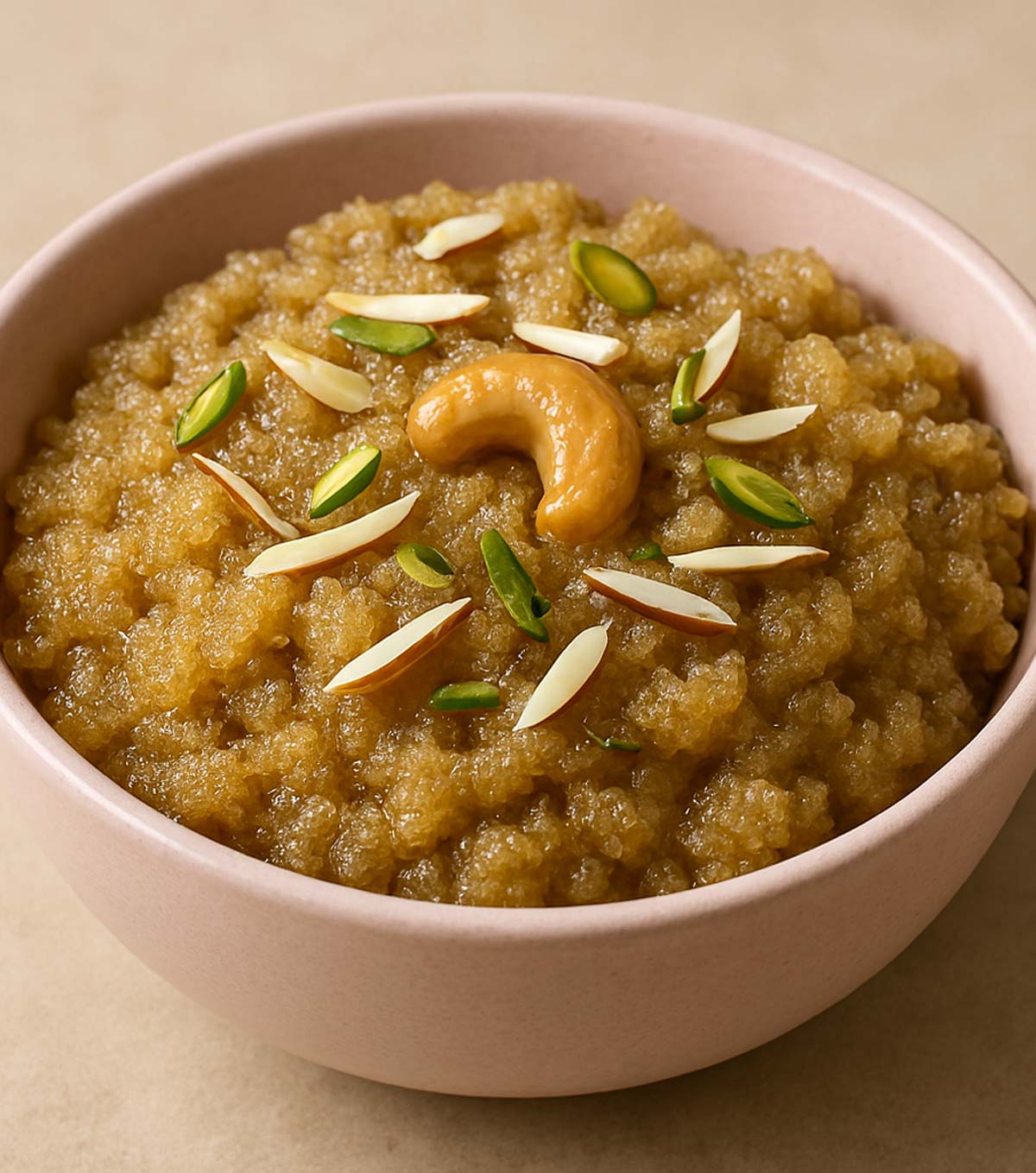
Recipe Card
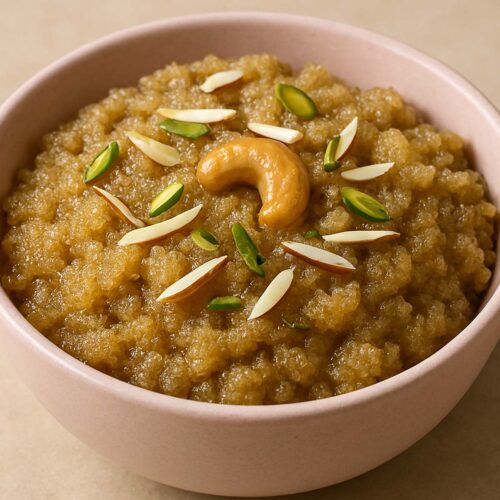
Sooji Halwa Recipe (Semolina Halwa)
Equipment
- 1 Heavy-bottomed pan
- 1 Spatula
- 1 Saucepan
- 1 Small frying pan
- 2 Measuring cups
- 5 Spoons
- 4 Serving bowls
Ingredients
- 1 cup suji semolina / rava
- 1 tbsp besan gram flour (optional)
- 1 cup sugar
- 2 cups water
- ½ cup ghee divided
- 2 tbsp ghee for roasting
- 10 cashews
- 10 almonds
- 10 pistachios optional
- Cardamom powder optional
Instructions
- Heat ghee in a pan and add semolina (suji) with a little gram flour (besan). Roast the semolina on low flame, stirring constantly, until it turns golden and aromatic.
- In a separate saucepan, bring water to a boil. Add sugar and stir until fully dissolved to form a light syrup.
- Slowly pour the hot syrup into the roasted semolina mixture, stirring continuously to prevent lumps. Cook on low heat until the mixture thickens and becomes glossy.
- In a small pan, heat ghee and fry cashews and almonds until golden brown. These add crunch and richness to the halwa.
- Add the fried nuts and ghee to the halwa. Sprinkle cardamom powder for a warm aroma. Cook for a few more minutes until the halwa turns soft, smooth, and ghee begins to separate. Serve warm.
Notes
- You can use medium or fine suji for best texture.
- Add a few saffron strands or rose water for flavor variation.
- For a richer halwa, you can replace water with full-fat milk. Serve with poori for a traditional breakfast.
- Refrigerate leftovers for up to 3 days.
- Reheat with a spoon of ghee or water before serving.
- Note: Calorie count may vary based on the amount of ghee and nuts used.

